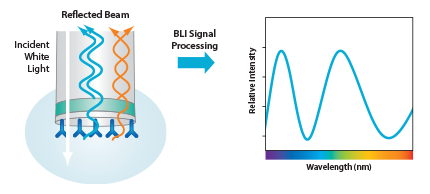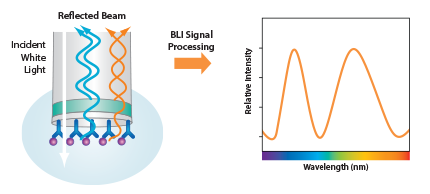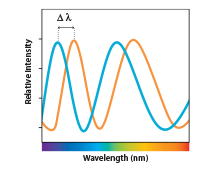Bio-Layer Interferometry (BLI) is a label-free technology for measuring biomolecular interactions. It is an optical analytical technique that analyzes the interference pattern of white light reflected from two surfaces: a layer of immobilized protein on the biosensor tip, and an internal reference layer (Figure 1). Any change in the number of molecules bound to the biosensor tip causes a shift in the interference pattern that can be measured in real-time (Figures 1 and 2).

Figure 1

Figure 2
The binding between a ligand immobilized on the biosensor tip surface and an analyte in solution produces an increase in optical thickness at the biosensor tip, which results in a wavelength shift, Δλ (Figure 3), which is a direct measure of the change in thickness of the biological layer. Interactions are measured in real time, providing the ability to monitor binding specificity, rates of association and dissociation, or concentration, with precision and accuracy.
Only molecules binding to or dissociating from the biosensor can shift the interference pattern and generate a response profile on the Octet® System. Unbound molecules, changes in the refractive index of the surrounding medium, or changes in flow rate do not affect the interference pattern. This is a unique characteristic of BLI and extends its capability to perform in crude samples used in applications for protein:protein binding, quantitation, affinity, and kinetics.

Figure 3
Key Benefits of BLI
- Label-free detection
- Real-time results
- Simple and fast
- Improves efficiency
- Crude sample compatibility
Literature References
References to Pall ForteBio's products in published literature.